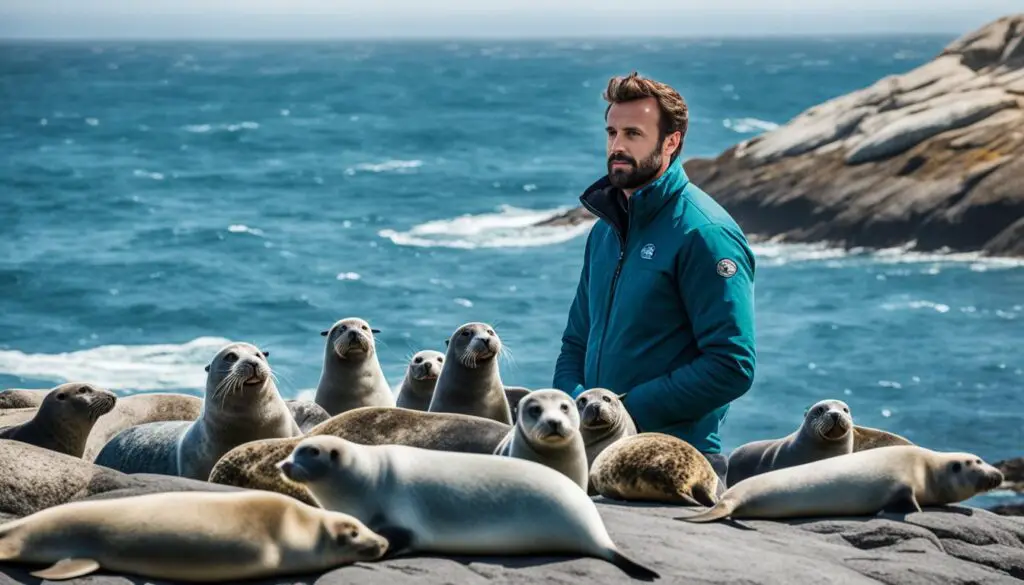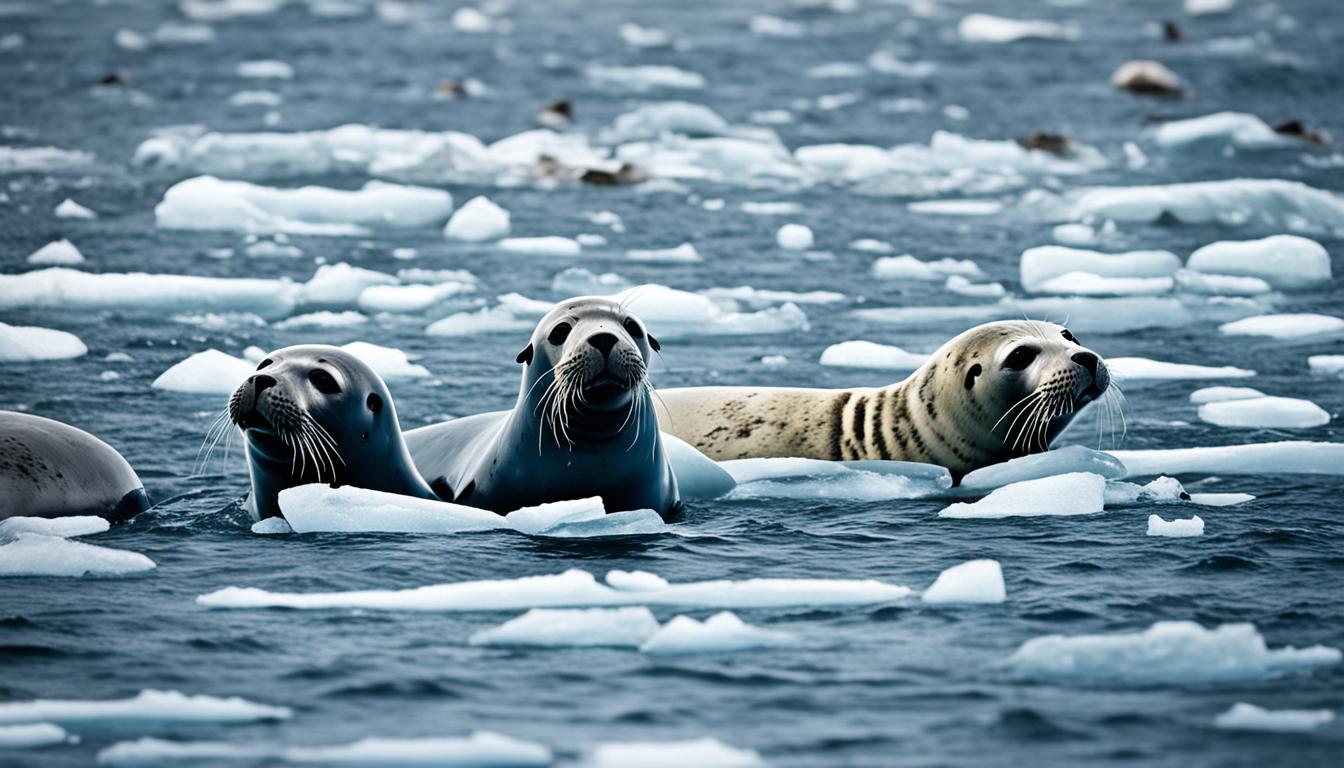Exploring seals and their interactions with humans is fascinating. It’s key to know how seals behave around people in different places. Seal-human meetings are more common, and understanding seal behavior makes your experiences safer for you and the seals.
This article will give you important facts about seal species like the Hawaiian monk seal and leopard seal. You’ll learn about their habits and why seals are important in nature. This knowledge helps you interact with seals responsibly and respect their space. It’s vital for your safety and the seals’ well-being to know how to interact with them properly.
Understanding Seal Behavior Around Humans
To understand seals’ behavior around people, we need to know about the seal species that often meet humans. We also need to understand their typical behaviors during these meetings. This knowledge helps us interact safely and respectfully, keeping stress levels low for both humans and seals.
Overview of Seal Species Involved in Human Encounters
Many seal species interact with humans, each with its own behaviors. The Hawaiian monk seal is shy and usually stays away from people, showing no aggression. On the other hand, the leopard seal might be curious but can act predatory if it feels threatened or if pups are around. Knowing these differences helps us understand seals better when they’re near people.
Typical Behaviors of Seals in Human Proximity
Seals react differently when near humans, from being curious to avoiding them. Their actions are influenced by their environment, the season, and what they’re doing, like looking for food or caring for their young. For instance:
- Curiosity: Seals might slowly come closer to check out humans and their surroundings.
- Avoidance: If they feel scared, seals will often go back into the water.
- Resting: Some seals prefer to sunbathe near people, not bothered by their presence.
Knowing these behaviors helps us predict how seals might react in different situations. This makes our meetings with them more enjoyable and safe.
| Seal Species | Behavior Characteristics |
|---|---|
| Hawaiian Monk Seal | Shy, non-aggressive, avoids human contact. |
| Leopard Seal | Curious, can exhibit predatory behaviors under certain conditions. |
| Gray Seal | Varied behavior—may approach or avoid depending on situation. |
How Do Seals Interact with Humans?
Learning about seal-human interactions can deepen your respect for these amazing animals. These encounters take place in many places, like during fun outings and scientific studies. Seals show different behaviors based on their type and the situation. It’s important to know these behaviors to keep both humans and seals safe and comfortable.
General Observations of Seal-Human Interactions
At the beach, seals often seem curious about people. They might swim near boats or relax on beaches where people are. But, how they react can depend on the seal’s type and past experiences with humans. It’s key to understand these differences to stay safe.
Case Studies: Notable Seal Encounters
Some seal encounters teach us a lot about interacting with these animals. For example, a story about a leopard seal and a marine biologist in Antarctica shows both the beauty and risks of such meetings. While most encounters are safe, these stories remind us to keep a safe distance when watching seals in the wild.
| Type of Seal | Common Behavior in Human Proximity | Notable Encounter Type |
|---|---|---|
| Harbor Seal | Curious; may approach boats | Swimming alongside kayakers |
| Leopard Seal | Defensive; may appear aggressive | Incident with marine biologist |
| Elephant Seal | Passive; often basks on beaches | Docile encounters with beach visitors |
Thinking about these examples helps us understand the interesting and sometimes tricky parts of human-seal interactions. Knowing about these interactions helps us be more respectful and safe around seals.
The Importance of Hawaiian Monk Seals in Their Ecosystem
Hawaiian monk seals are crucial to their marine homes. They have special traits and behaviors that help them and the environment around them. Learning about these can make you appreciate these amazing animals more.
Unique Traits and Vocalizations
Hawaiian monk seals stand out with their sleek bodies, perfect for ocean life. They make unique sounds to talk to each other. These sounds are important for their social life, helping them live together well.
Role as a Keystone Species
Hawaiian monk seals are key to the ocean’s health. As top predators, they control the numbers of other sea creatures. This keeps the ocean’s balance right, showing why we must protect these seals.
Human Perception of Seals: Myths and Realities
Humans have a complex view of seals, shaped by history and the media. These marine mammals have always caught our attention. But, they often get a bad rap, thanks to myths that range from kind to scary. These myths affect how we see and treat seals in the wild.
Historical Context and Influences on Public Perception
Humans and seals have had a complicated history. In the past, seals were seen as threats, especially by fishermen. This led to a fear that they could take our food, causing tension in some places. This fear still affects how people see seals today.
Impact of Media on Seal Reputation
The media greatly shapes how we view seals. Through documentaries and news, seals can be seen as heroes or as pests. A good story can make people love and support seals more. But, scary stories can make people think seals are mean, leading to wrong ideas about them.

| Aspect | Positive Media Influence | Negative Media Influence |
|---|---|---|
| Public Awareness | Increases knowledge and admiration for seals | Fosters fear and misunderstanding |
| Conservation Support | Boosts funding and community involvement | Reduces support due to perceived threats |
| Behavioral Myths | Promotes understanding of seal behavior | Perpetuates myths about aggression |
Safe Practices for Human-Seal Interaction
When you interact with seals, it’s important to do so safely. This keeps both humans and seals safe. Following the right guidelines makes the experience better for everyone.
Recommended Viewing Distances and Guidelines
It’s key to watch seals from a safe distance. You should keep at least:
- 50 feet away from seals on land
- 150 feet away from mothers with pups
This keeps seals from getting stressed and lets you have a great time. Knowing and following these rules makes everyone safer.
What to Do If You Encounter a Seal
If you’re near a seal, act wisely. Stay calm and do these things:
- Don’t touch or feed the seal.
- Slowly move back to give the seal space.
- If you see a sick or stranded seal, tell local wildlife authorities.
These steps are key to safely interacting with seals. Knowing what to do helps protect these amazing animals.
Human Impact on Seal Behavior
Exploring the relationship between humans and seals shows how your actions affect them. Studies reveal that more human activity near their homes and feeding spots harms their behavior. Seals may leave their young or change where they hunt because of stress from humans.
This shows we need to protect their homes from too much human contact.
Research Findings on Human Disturbances
Research shows how humans hurt seal behavior. Seals get stressed when humans get too close, especially when they’re having babies. This stress can make them have fewer babies and be less healthy.
It’s important to learn about these disturbances to make sure we don’t bother seals too much.
Consequences of Feeding and Interaction
Feeding seals might seem harmless, but it can make them depend on humans for food. This changes their natural hunting habits. It can also upset the balance of the ocean’s food chain.
It’s key to keep a safe distance and let seals live as they should in the wild.









